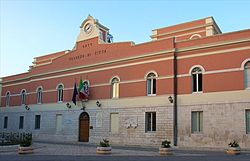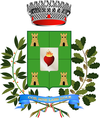Corato
| Corato | ||
|---|---|---|
| Comune | ||
| Comune di Corato | ||

Town hall.
|
||
|
||
| Location of Corato in Italy | ||
| Coordinates: 41°9′N 16°24′E / 41.150°N 16.400°E | ||
| Country | Italy | |
| Region |
|
|
| Province / Metropolitan city | Bari (BA) | |
| Frazioni | Oasi di Nazareth | |
| Government | ||
| • Mayor | Massimo Mazzilli | |
| Area | ||
| • Total | 167 km2 (64 sq mi) | |
| Elevation | 232 m (761 ft) | |
| Population (30 November 2015) | ||
| • Total | 48,298 | |
| • Density | 290/km2 (750/sq mi) | |
| Demonym(s) | Coratini | |
| Time zone | CET (UTC+1) | |
| • Summer (DST) | CEST (UTC+2) | |
| Postal code | 70033 | |
| Dialing code | 080 | |
| Patron saint | St. Catald | |
| Saint day | 10 May | |
| Website | Official website | |
Corato is a town and comune in Italy. It is located in the Bari province of the Apulian region, in southeastern Italy. Founded by the Normans, it became subject to Alfonso V, king of Aragon, at the end of the 15th century, and later to the Carafa family. The chief feature of the old town centre, which is surrounded by modern buildings, is the Romanesque church. It is a twin city of Grenoble, France, where many Coratini immigrated during the 20th century.
Corato was founded in 1046 by Peter I of Trani, adding a castle, four angular towers, the perimetery enclosing walls, four access gates, and two main perpendicular streets. These elements, typical of a mediaeval town, were preserved until the 16th century. From the 17th century onwards Corato started to extend from all four sides of the Norman falling walls, and numerous churches and aristocratic palaces were built.
Today Corato is an agricultural and industrial centre of the hinterland of Bari, placed 43 kilometres (27 mi) west from it and at 232 metres (761 ft) above sea level. It is well known for the olive production: the Coratina olive's name comes from Corato.
On 12 July 2016, a head-on collision between two passenger trains occurred near Corato. At least 23 people were killed and dozens more injured.
Corato is twinned with:
...
Wikipedia


